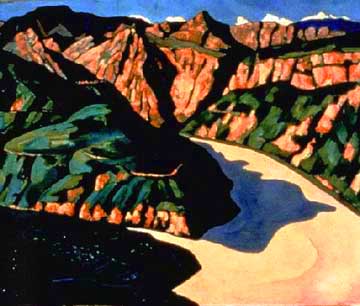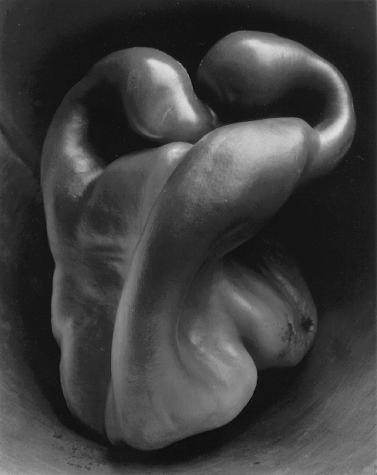5.06.2008
Masters of Photography
I thought this video would be a good way to end the semester. It is an accumulation of photographs from the greatest photographers in the past 100 years. Enjoy!!!
Artist Bio & Statement.
We were asked to write an Artist bio. as well as an artist statement for the "Hello Holga" show. This is mine, I combined the two together.
"I have been exploring photography for the past four years, but within the last two I have found myself exploring the darkroom rather than my predominantly digital past. My recent photographic endeavors utilize a 35-mm SLR as well as a Holga 120, both with black and white film. I try to choose subject matter that is recognizable but present it in a way which requests another look from the viewer. Interesting angles, dramatic lighting, and purposeful cropping drive my photography.
For 'Hello Holga,' I hoped to reflect and highlight the naturally eerie quality of Holga photographs with subject matter which was equally as eerie and ambiguous. I chose to represent outdoor scenes in which the timeframe would be at question, the before and after explanation of the scene up for grabs, and the actual setting unanswered. A lone van, a scrawling, untrimmed bush, and a dilapidated shed leave the viewer to wonder what exactly happened here. I can't tell you, so you'll just have to guess."
I thoroughly enjoyed this class, and having a show at the end makes it all seem even more worthwhile!
"I have been exploring photography for the past four years, but within the last two I have found myself exploring the darkroom rather than my predominantly digital past. My recent photographic endeavors utilize a 35-mm SLR as well as a Holga 120, both with black and white film. I try to choose subject matter that is recognizable but present it in a way which requests another look from the viewer. Interesting angles, dramatic lighting, and purposeful cropping drive my photography.
For 'Hello Holga,' I hoped to reflect and highlight the naturally eerie quality of Holga photographs with subject matter which was equally as eerie and ambiguous. I chose to represent outdoor scenes in which the timeframe would be at question, the before and after explanation of the scene up for grabs, and the actual setting unanswered. A lone van, a scrawling, untrimmed bush, and a dilapidated shed leave the viewer to wonder what exactly happened here. I can't tell you, so you'll just have to guess."
I thoroughly enjoyed this class, and having a show at the end makes it all seem even more worthwhile!
Hello Holga!
My Creative Photography class has decided to have a show featuring our best works from the Holga cameras. We named the show "Hello Holga" and it will be in the Liberal Arts building on the second floor. I'm very excited to have my work up in this show. Today we hung everything up and it looked fantastic. All of the photography was window-matted and framed. We all had artist statements to go alongside our work which just seemed to complete it all. I'm very pleased with the outcome. Although it was a challenge nailing everything into the wall and making sure things were level!
Marsden Hartley

We were recently assign to visit our local art museum, BAM, and look at an exhibition about Marsden Hartley, titled American Modern. Marsden Hartley is one of the most important artists from the American early modern period. He was part of the influential group surrounding Alfred Stieglitz in the early decades of this century.
 Arthur Dove, John Marin, Georgia O'Keeffe, and Paul Strand were among his colleagues and, with Hartley, core artists of the Stieglitz circle. The exhibition offered a new and important retrospective of Hartley, tracing his evolution in both art and philosophy. Some of the works at the museum included "Dead Plover," "North Atlantic Harvest," and "Santos, New Mexico." There was also a Steiglitz portrait of Marsden which I have pictured to the right. When I looked up his work on google, I found some other pictures which I'll put below.
Arthur Dove, John Marin, Georgia O'Keeffe, and Paul Strand were among his colleagues and, with Hartley, core artists of the Stieglitz circle. The exhibition offered a new and important retrospective of Hartley, tracing his evolution in both art and philosophy. Some of the works at the museum included "Dead Plover," "North Atlantic Harvest," and "Santos, New Mexico." There was also a Steiglitz portrait of Marsden which I have pictured to the right. When I looked up his work on google, I found some other pictures which I'll put below. 


Edward Weston

Edward Weston began his career of photography at the young age of 16, his style being predominantly pictorial in nature. However, later in life after establishing himself a firm photography career, he renounced pictorialism in favor of straight photography, he would later become known as the "pioneer of precise and sharp presentation" with images of natural forms such as the human figure, seashells, plants, vegetables, and landscapes. His straight photography is very famous and I find it very beautiful. Perhaps I am more attracted to his later works than his earlier works.

Sally Mann

We recently watched a video of Sally Mann in class, and some of the works featured in the video were part of her bone collection. She is infatuated with death and decomposition, the way life recycles itself. Death is comforting to her. She is attracted to ambiguity and tries to capture this in her photography. She firmly believes that you shouldn't take a photograph without having ambiguity, otherwise the photograph is meaningless. Sally Mann is known for taking pictures of her family and children--especially the nude portraits of her children that have often been said to be suggestive in nature. She also believes in a very large format camera.

Edward Steichen

Edward Steichen, once a fine art painter, soon found himself taking on photography with a pictorialist approach, which he soon mastered. In 1905, Steichen helped create the Little Galleries of the Photo-Secession with Alfred Stieglitz. After World War I, during which he commanded the photographic division of the American Expeditionary Forces, he reverted to straight photography, gradually moving into fashion photography. Steichen's 1928 photo of actress Greta Garbo is recognized as one of the definitive portraits of Garbo.
I think it is important for me to look at Steichen's work especially with our recent Holga endeavors. In many ways, the results of Holga photography are "pictorialist," much like Steichen's photography. He was a master at what he did, and it is always good to look back at the masters and learn from their ways.
Alfred Stieglitz

Subscribe to:
Comments (Atom)
